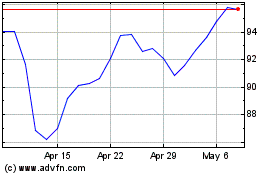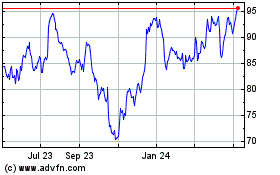By Liz Hoffman
Morgan Stanley posted its best fourth-quarter results since the
financial crisis, keeping a lid on expenses and growing revenue in
both its core Wall Street businesses and its newer wealth
franchise.
The New York-based firm reported a profit of $1.67 billion, or
81 cents a share, in a quarter that included a surge of
postelection trading activity. That compares with $908 million, or
39 cents a share, a year earlier.
Revenue grew 17% to $9.02 billion. Analysts polled by Thomson
Reuters had expected revenue of $8.47 billion and earnings of 65
cents a share.
"This is what you came for," Evercore ISI analyst Glenn Schorr
wrote of investors who have pushed Morgan Stanley's shares up about
22% since Election Day. The gains notched by all financial stocks
reflected investors' hopes that a Trump administration would result
in lighter regulation, stronger economic growth and higher interest
rates.
For all of 2016, Morgan Stanley's revenue fell 1.5% versus the
prior year and net income dropped 2.4% as a strong second half
failed to fully compensate for a sharp drop in markets at the start
of 2016.
"It's fair to say the year finished a lot better than it began,"
Chief Executive James Gorman said on the firm's earnings call
Tuesday. "There is certainly more reason to be optimistic."
Morgan Stanley has lately avoided expensive legal mistakes and
improved in trouble spots like debt trading.
But its return on equity, a key measure of profitability,
remains short of its 10% target. Many big banks have struggled to
beat that yardstick since the financial crisis, but Mr. Gorman, CEO
since 2010, has made clearing it a central goal for the bank -- one
his job may hinge on.
Mr. Gorman has in the past blamed the bank's stubbornly low
returns on the amount of capital regulators require it to hold.
Last spring, Morgan Stanley received Federal Reserve approval to
increase its shareholder payouts for 2017 though it was required to
resubmit its plan to address shortcomings. It did so last
month.
Morgan Stanley stock was down more than 2% in early trading
Tuesday as the financial sector fell.
Morgan Stanley faced high expectations following fairly strong
earnings from rivals J.P. Morgan Chase & Co. and Bank of
America Corp. last week that AllianceBernstein analyst John
McDonald called "good enough to keep the dream alive."
While nearly all of Morgan Stanley's businesses posted stronger
quarters, the big contributor was debt trading, traditionally a
weak spot. The unit nearly tripled revenue to $1.47 billion. That
marked the third straight quarter the firm cleared a $1 billion
target for this business laid out by Mr. Gorman.
Morgan Stanley did so with 25% fewer traders after layoffs last
year, and while taking less risk.
The gains follow a shake-up last year, in which Mr. Gorman
combined stock and debt trading and put a top equities deputy in
charge of both. Since then, reporting lines have been clarified and
the two desks are better sharing resources and technologies, Mr.
Gorman said Tuesday.
Investment-banking revenue rose 4.9% as higher merger and
debt-underwriting fees offset a decline in initial public
offerings. Morgan Stanley ranked as the No. 2 M&A adviser last
year, behind Goldman Sachs Group Inc., which reports fourth-quarter
results Wednesday.
Despite the attention paid to its core securities businesses,
Morgan Stanley is starting to look more like the bank it is,
pushing further into activities like deposit-taking and lending.
Assets in its U.S. banking unit hit a record $180 billion, and the
firm has continued to increase its lending book.
Mortgages are up 17% year-over-year and loans backed by stock
portfolios or other assets like art or businesses are up 26%.
Part of that push comes from wealth management where an army of
brokers are now peddling loans alongside investment and retirement
advice. The wealth management division posted higher revenue and a
record $3.4 billion in pretax earnings for the year.
Advising Americans on their retirement and managing their
investments now accounts for about 40% of Morgan Stanley's profits
-- once unthinkable for a firm that clung to its investment-banking
roots. For the first time ever, each of its 15,800 brokers is
billing $1 million on an annualized basis.
Fees from these businesses don't swing as much and are viewed
more favorably by regulators. But they are less profitable because
wealth advisers keep a larger haul of the revenue they bring in
than bankers or traders.
Over all, Morgan Stanley paid out 46% of its 2016 revenue in
compensation compared with 47% last year.
Expenses for the firm fell 3.3% as Mr. Gorman seeks to make good
on his promise to trim $1 billion in costs this year. But he warned
on the earnings call against being "penny-wise and pound-foolish"
by cutting compensation too deeply and losing top employees.
Among major businesses, the lone blemish was the
investment-management division, Morgan Stanley's smallest. Revenue
fell 19% and profits dropped 60% after the bank wrote down or sold
legacy private-equity investments and recognized a $60 million
loss. Its pretax profit margin fell to single digits.
The division manages money for other asset managers, pension
funds and corporations. It has grappled with a shift toward passive
investing and new regulations affecting money-market funds.
Write to Liz Hoffman at liz.hoffman@wsj.com
(END) Dow Jones Newswires
January 18, 2017 02:48 ET (07:48 GMT)
Copyright (c) 2017 Dow Jones & Company, Inc.
Morgan Stanley (NYSE:MS)
Historical Stock Chart
From Mar 2024 to Apr 2024

Morgan Stanley (NYSE:MS)
Historical Stock Chart
From Apr 2023 to Apr 2024
